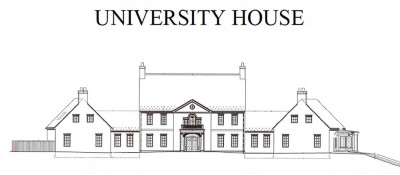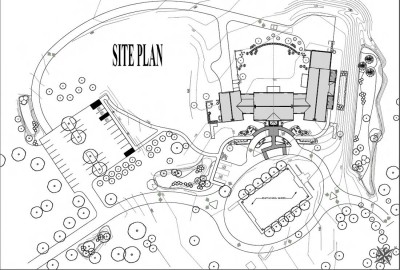

The front elevation and site plan for the new University House which will house the University of Maryland's president. The $7.2 million slated for the project is being provided by private funds raised by the University of Maryland’s College Park Foundation. The facility will sit on state-owned property at the university. (Image source: University of Maryland’s College Park Foundation)
(January 05, 2012)—Comptroller Peter Franchot criticized the University of Maryland’s College Park Foundation’s use of $7.2 million to rebuild the university president’s palatial on-campus residence, as he cast the sole vote opposing the demolition of the current home at Wednesday’s Board of Public Works meeting.
The other two board members, State Treasurer Nancy Kopp and Lt. Gov. Anthony Brown – sitting in for Gov. Martin O’Malley – voted in favor of the demolition. The building, located on the west side of campus, is scheduled to be torn down this month.
Because the current university president’s home is state-owned and located on the College Park campus of the University of Maryland, the Board of Public Works had to grant approval for the privately funded project to go forward.
Franchot said that even though the money for the project comes from the foundation, which receives its funds through donations from alumni and friends of the flagship campus, using money to replace a mansion looks bad inder current financial conditions. The fact that the university may cut eight athletic teams if they cannot raise money to sustain themselves makes the construction project look even worse, Franchot said.
“The university is saving every penny it can, but a building that is perfectly habitable is being demolished,” Franchot told representatives of the university and the foundation. “I don’t see how you respond to your constituents.”
Carlo Colella, associate vice president for facilities management at the university, said that the current president’s home was built in 1956. By today’s standards, it has several problems. The building is not handicapped accessible, has asbestos inside, and does not have proper safety details like a sprinkler system.
“It wouldn’t meet codes if it were newly constructed,” Colella said.
The president’s residence is not just a home for the campus’ top administrator and his or her family. It is also used for official functions, including university fundraisers. Colella said that the main event space in the current residence is a converted garage, and tents often have to be rented in order to accommodate people attending.
Brodie Remington, president of the College Park Foundation, said that the foundation had taken a hard look at the current residence of the university president, finding it would be more costly to renovate than rebuild. The foundation then started moving forward to plan and raise funds for the new building.
“We believe that this will have a considerable return on investment of the foundation funds we’re putting into it, and increased fundraising,” Remington said.
The new building will be near the current one, and the land from the current home will be landscaped as part of the residence. The new structure will be about 14,000 square feet, with 4,000 square feet for living space, and the rest as public rooms for events and fundraising. According to a report from the College Park Foundation, the events center in the new residence will fit up to 125 people seated, and up to 350 standing. University President Wallace Loh had no input in the process, which had started before he was hired, according to the foundation.
Colella said that site work has already started, and the project will go forward quickly this year. The new home should be completed and ready for Loh to move in at the beginning of the fall semester in August.
Franchot said he could not understand how rebuilding a mansion could be the best use of the foundation’s money, especially since the mansion is only 56 years old.
Kopp said that it was apparent to everyone who attended events in the mansion that it needed to be replaced.
Brown was not so sure about the wisdom of using money on the project, but people made donations to the foundation in order to build the new president’s home.
“While I’m perhaps pleased that this is not public money, that changes the equation for me,” Brown said. “The alumni gave money for this project, and that’s where they wanted their money to go.”
RELATED INFORMATION:
An Overview of University House by the University of Maryland College Park Foundation
http://www.foundation.umd.edu/.../University_House_Package.pdf


